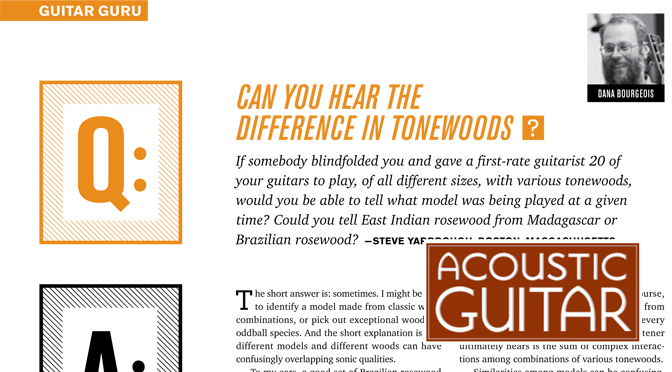Guitar Guru
Guitar Guru – Identifying Tonewoods by Sound
Dana Bourgeois contributes the monthly Guitar Guru column to Acoustic Guitar Magazine. If you a question you’d like Dana to address in an upcoming article, please submit it to [email protected].
Download a PDF of this article here
CAN YOU HEAR THE DIFFERENCE IN TONEWOODS?
Q: If somebody blindfolded you and gave a first-rate guitarist 20 of your guitars to play, of all different sizes, with various tonewoods, would you be able to tell what model was being played at a given time? Could you tell East Indian rosewood from Madagascar or Brazilian rosewood? —STEVE YARBROUGH, BOSTON, MASSACHUSETTS
A: The short answer is: sometimes. I might be able to identify a model made from classic wood combinations, or pick out exceptional woods or oddball species. And the short explanation is that different models and different woods can have confusingly overlapping sonic qualities.
To my ears, a good set of Brazilian rosewood has a ring-y, mildly metallic (vs. woody) tone with even lows, mids, and highs, and a slightly wet, or reverby finish. When I tap a set, I like to hear a “gong” and a “ping” at the same time, with good sustain. But not all Brazilian fits this description. A set having a somewhat less gong-y bass and slightly drier finish might be more reminiscent of Madagascar rosewood. And tone is, of course, produced not only from the back, but also from the top, and probably in some way from every other part of the instrument. What the listener ultimately hears is the sum of complex interactions among combinations of various tonewoods.
Similarities among models can be confusing, too. Many years ago I asked Tony Rice to critique several of my dreadnoughts. His response was invariably polite though not always encouraging. On one occasion he asked to see what was in another case I had brought, so I handed over an OM I hadn’t intended to show him. Tony’s comment opened my ears and, to this day, guides my career: “Make your dreadnoughts sound like this one, man.”
So what’s the inherent difference between the sound of an OM and a D? Well, it depends on the instrument.
To fully appreciate differences among guitars, you really need to be the player. A good player often makes adjustments not always apparent to the listener—in dynamics, timbre, or inflection— to compensate for overly prominent or marginal qualities in an individual guitar. Or simply for effect. I remember once watching a favorite player dump out a bag of picks, then work through various combinations of picks and guitars before settling on a certain sound. In that case, the sound was probably more about the pick than the wood or the model.
But it was mostly about the player.
Even if I knew all the guitars in advance, I might only be able to pick four or five out of 20. At first, this sounds discouraging. Why, then, do we need all these guitars? The best answer I can think of brings to mind a line from one of my favorite Doc Watson songs: “Any ole’ town that I ramble all around in, there’s more pretty girls than one . . . . ”

